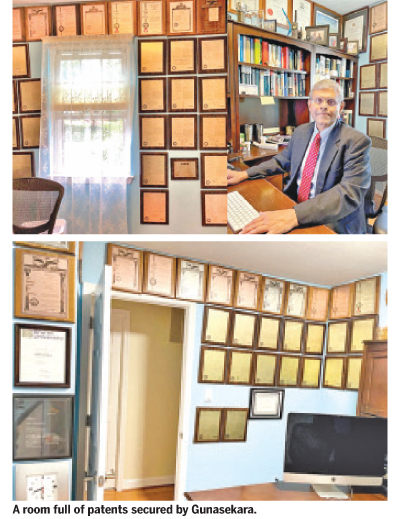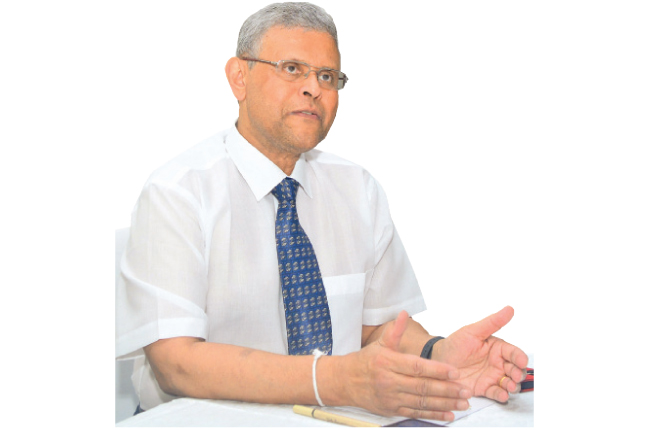Getting a patent approved is generally considered a long and difficult process. The process can be even harder for Sri Lankans living abroad. Yet geniuses are born and made to overcome such challenges. They know no barrier.
Don Hemachandra Gunasekara is a case in point.
Growing up in Koratota, Gunasekara was always pursuing knowledge. He had a never-ending thirst for excellence. It was during his A-Levels in the science department that Gunasekara’s passion for innovation began to take shape. Technology fascinated him. It is that technology that took him offshore to the UK, the US and so on. His first step was a degree in Electronic Engineering and Computer Science.
 Gunasekara’s dedication and diligence bore fruit as he earned his first degree and went on to begin his career as an engineer in England. However, it was in America that Gunasekara’s career reached heights. Over 33 years spent in the United States, in addition to his tenure in England and Canada, Gunasekara established his position as an innovator.
Gunasekara’s dedication and diligence bore fruit as he earned his first degree and went on to begin his career as an engineer in England. However, it was in America that Gunasekara’s career reached heights. Over 33 years spent in the United States, in addition to his tenure in England and Canada, Gunasekara established his position as an innovator.
124 patents
One noteworthy contribution is his role in providing telephone exchanges to his homeland, Sri Lanka, through Nortel company. To date, he has secured 124 patents.
“I hold a total of 124 patents, with 116 of them personally acquired. The remaining 8 were collaboratively obtained through initiatives with students. Acquiring patents in the United States is a rigorous process, necessitating thorough research and demonstrating certainty in the innovation. Typically, obtaining a patent takes around 5 years, but I’ve experienced instances where I’ve secured patents within a remarkably short span of 9 months. The majority of my patents originate from scientific research areas such as satellite technology, internet technology, and magnetism.”
Among his notable patents is a technology related to mobile phones and satellites, which enables connectivity even in areas beyond the reach of traditional cell towers. Filed for patent approval in 2013 and granted in 2015, this technology ensures protection until 2035, adhering to the standard 20-year patent duration.
The patented technology facilitates automatic switching between satellite and mobile phone connectivity, ensuring uninterrupted communication regardless of geographical location. This innovation not only enhances user experience but also holds significant implications for caller identification systems.
 “Among my patents, one significant innovation pertains to mobile phone and satellite technology. This innovation addresses the scenario where a mobile phone, operating within the coverage area of a cell tower, abruptly loses signal upon leaving that area. To resolve this, I introduced a technology enabling seamless transition to satellite connectivity when the phone exits the coverage zone. This innovation automatically detects the absence of cellular coverage and seamlessly switches to satellite connectivity, ensuring uninterrupted communication.I initiated the patent application process for this technology in 2013, and it was successfully granted in 2015.”
“Among my patents, one significant innovation pertains to mobile phone and satellite technology. This innovation addresses the scenario where a mobile phone, operating within the coverage area of a cell tower, abruptly loses signal upon leaving that area. To resolve this, I introduced a technology enabling seamless transition to satellite connectivity when the phone exits the coverage zone. This innovation automatically detects the absence of cellular coverage and seamlessly switches to satellite connectivity, ensuring uninterrupted communication.I initiated the patent application process for this technology in 2013, and it was successfully granted in 2015.”
Examination process
For a patent to be awarded, the technology or tool must exhibit novelty and utility, and it must endure for a minimum of 20 years. The granting of a patent involves a meticulous examination process to ensure the uniqueness and viability of the invention.
“The patented technology I developed not only enables transition from mobile phone coverage to satellite connectivity but also ensures automatic reconnection to the mobile phone system upon reentering the coverage area. This integration of mobile phone and satellite technologies required careful attention to various systems, including caller identification, to ensure a smooth and efficient user experience.”
This pioneering technology, blending the capabilities of both mobile phone and satellite systems, has paved the way for the next frontier in telecommunications. This advancement has been recognised as a milestone, leading to the emergence of what is now termed as the ‘6th Generation’ (6G) technology. Even as we continue to harness the potential of 5G technology, the introduction of 6G marks a new chapter in telecommunications innovation.
Gunasekara’s contributions extend to pioneering work in smart vehicle technology, particularly focused on electric vehicles (EVs). His innovation addresses critical information needs for EV users, including real-time data on remaining charge levels, proximity to charging stations, availability of charging facilities, and estimated charging times.
“I’ve developed a technology to address the challenges of electric vehicle (EV) charging infrastructure. Leveraging power lines embedded in roads, my innovation provides a solution to gather essential information for EV users, irrespective of mobile phone coverage limitations.
My technology allows users to ascertain the remaining charge in their vehicles, the proximity to the nearest charging station, the availability of charging slots, and the estimated charging time. It provides real-time data on the number of vehicles currently undergoing charging at a specific location and the availability of vacant charging slots.”
EV infrastructure
This innovation not only bridges a significant gap in existing EV infrastructure but also streamlines the charging process, optimising efficiency and convenience for users. Gunasekara has opened up possibilities for widespread adoption and enhanced usability of electric vehicles, contributing to the transition towards sustainable transportation.
Gunasekara’s innovation remains widely adopted, particularly in American smart vehicles.
 “I developed a specialised plan to provide WiFi facilities in high-density areas such as stadiums, where large crowds gather, particularly during events like football matches where instantaneous connectivity is crucial. Traditionally, it has been challenging to cater to the massive surge in WiFi usage, with tens of thousands of individuals simultaneously accessing the network.
“I developed a specialised plan to provide WiFi facilities in high-density areas such as stadiums, where large crowds gather, particularly during events like football matches where instantaneous connectivity is crucial. Traditionally, it has been challenging to cater to the massive surge in WiFi usage, with tens of thousands of individuals simultaneously accessing the network.
In response to this challenge, I devised a tiered approach, categorising users into different classes based on the fees they pay. This segmentation allows for more efficient WiFi management, ensuring a smoother experience for all users. For instance, Class 1 users, who pay higher fees, receive priority access and enhanced bandwidth, while Class 2 and other classes have access to varying levels of service based on their fees.”
This innovative approach, which was patented 15 to 20 years ago, predates modern concepts like Platinum, Gold, and Silver tiers.
Patent solution
Throughout his career, Gunasekara’s patents have served as solutions to the needs and challenges encountered in the companies where he worked. From his early days in England to his tenure in Canada, Korea, and Japan, Gunasekara’s global experiences have enriched his innovative exercises. During his time with Nortel Network in Canada, which specialised in telephone exchanges, Gunasekara secured a number of patents.
Gunasekara’s stint at Samsung during his tenure in Korea provided him with insights and experiences within the country’s leading telecom company. Here, he focused on caller identification technology for wireless landline telephones, utilising Voice Over IP (VOIP) technology. Gunasekara obtained a patent for this innovation in nine months.
Throughout his career, Gunasekara held key positions at several prominent companies in different countries and continents – from his early days as a Research Engineer at GEC in the United Kingdom to his tenure as an Executive Engineering Director at Siemens in America.
Despite the demands of his career, Gunasekara remained deeply rooted in his commitment to his homeland, Sri Lanka. He built a house in Mount Lavinia for his own stay, and later offered it to the Buddha Sasana. Despite retiring from his primary occupation, Hema remained actively involved in service, dedicating his time to the West Virginia Meditation Center in the United States.
Sachitra Mahendra






